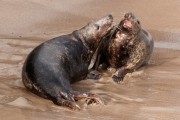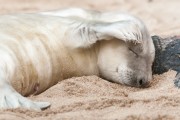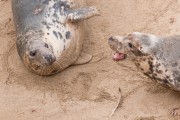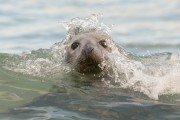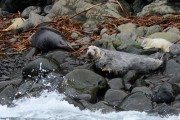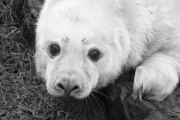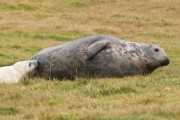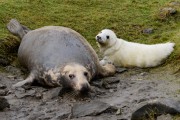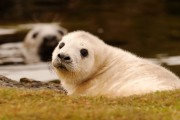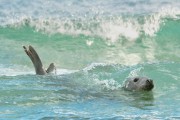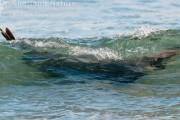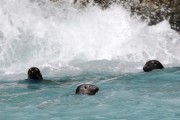Grey Seal pupping season
Posted by Brydon Thomason on Friday 4th January 2013 | Sea Mammals in Shetland
In Shetland Atlantic grey seal pupping season begins in mid to late October through to the end of November; some of the earliest may begin pupping as early as mid-September and exceptionally late individuals may still be in the colonies in early December. Interestingly the colonies on the west side of Shetland begin pupping earlier than the east side ones.
Here they usually choose to give birth on beaches of small ‘geos’ among fairly high remote cliffs or on small offshore islands, meaning that many colonies are often inaccessible without a boat.
Each year I and many other volunteers assist Scottish Natural Heritage in carrying out their annual Grey Seal pupping census around Shetlands many colonies. The variation in habitats here is quite fascinating; in many colonies they give birth at the foot of towering sea cliffs; on pebble and sand beaches, amongst massive boulders and in caves and on grass on low lying offshore islands. This diversity of habitats offers many differing photo opportunities and environments to enjoy them. Unfortunately few of these colonies are exempt from the unforgiving gales that Shetland can experience and the pups are extremely vulnerable in their first few weeks.
There is something very special and exciting about visiting the inaccessible colonies by boat, and to experience the atmosphere these colonies have in late autumn. I often think on them as ‘sea mammal maternity wards’!
Grey seal mothers will nurse the pups for 17-18 days, during which time she remains on the beach and will not feed herself. The pup can gain up to an impressive 2kg of weight per day from her extremely fat-rich milk and is then left to fend for itself, living solely off their blubber reserves. When born, the pups have an absolutely adorable thick, fluffy white coat that takes anything from two to four weeks after weaning, to moult out into their waterproof adult coats. During this time, they cannot swim and are at risk of being swept away by heavy winter seas.
Once taking to the wild and untamed ocean, young seals have been known to wander up to 1,000 km or more from their original place of birth. When pup’s finally take to the ocean they will learn to dives of up to 20 minutes long and to as deep as 300m although the normal depth would be 30-80m. The average life expectancy for a female is about 35 years, males only 25, although the oldest grey seal ever recorded in the world was one in Shetland, a ripe old age of 46!
During the pupping season, the males, which can weigh an impressive 310kg, patrol the colonies keeping a watch on their harem and can go for over six weeks without eating in order to certify the mating with females, which takes place within a day of the females leaving their pups. Amazingly, the females delay their 11 month pregnancy for a month after mating.
The Shetland population is estimated to be around 3,500 which is a fairly healthy population given that the UK population is about 105,000 (nearly 50% of the world total). Although most Shetlanders now know seals to be collectively known as ‘sealkie’, grey seals were once known locally by fishermen as ‘haaf fish’. It’s hard to relate to what the Latin name ‘halichoerus grypus‘, translates as; ‘hooked pig nose of the sea.’
Special care and consideration must be given if visiting colonies as mothers and pups are often very sensitive to disturbance and you should always respect their ‘comfort zone’ and avoid disturbance. Details of this can be found on the SNH website: http://www.snh.gov.uk/news-and-events/press-releases/press-release-details/?id=782


